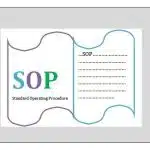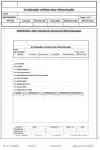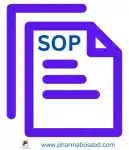Learn how to prepare a standard procedure for Annual Product Quality Review (APQR) in Pharmaceuticals.
Table of Contents
1.0 PURPOSE
To describe a standard procedure that gives guidance for Annual Product Quality Reviews (APQRs) of all pharmaceutical products that are marketed. includes gathering data, analyzing data, and having the technical team review the data.
2.0 SCOPE
This SOP is applicable to all departments that manufacture, pack, inspect, and test items during the course of a calendar year, from January to December. In this time frame, every batch that was ultimately closed is covered by annual product reviews in the pharmaceutical industry.
3.0 RELATED DOCUMENTS
Testing Procedure, Test Report, Summary Report, and other products related to APQR.
4.0 DEFINITIONS
4.1 Annual Product Quality Review (APQR): The Annual Product Quality Report (APQR), often referred to as the Product Quality Review (PQR), is a comprehensive document that plays a critical role in the GMP compliance process. It provides an annual review of the quality and performance of a drug product or range of products, ensuring that they continue to meet the intended specification
4.2 Date and Period of APQR: An APQR includes the date through which all batches were created, issued, and intended for packaging. It counts from January to December every year.

5.0 PRECAUTIONS
N/A
6.0 RESPONSIBILITY
6.1 Production Department
6.1.1 At the appropriate batch phase, enter the pertinent data.
6.1.2 Check all necessary product manufacturing and packaging data to make sure no entry is missing.
6.1.3 Describe the current Equipment Qualification status and other data as needed in the summary report.
6.2 Quality Control Department
6.2.1 At the appropriate batch phase, enter the pertinent data.
6.2.2 Check the necessary quality control data to make sure no entry is missing.
6.2.3 Describe the current state of the Pharmacopoeial review, shelf life study, reference standards, and analytical method validation.
Read Also: SOP of SOP in Pharmaceutical
6.3 Quality Assurance Department.
6.1.1 At the appropriate batch phase, enter the pertinent data.
6.1.2 Check the data requested by QA to make sure there are no missing entries.
6.1.3 Identify outstanding issues from prior APQR follow-ups, and 3.1.4 Continue with remedial measures that the Technical Team highlighted during APQRs.
6.4 Accountability
Head of Quality Assurance
7.0 PROCEDURE
7.1 Prepare for APQR
7.1.1 The QA Department completes a list of “Selection of Batches for APQRs” that identifies the specific items to be examined. An APQR is carried out in the first month of the year (i.e., January) to evaluate the previous working year.
7.1.2 Production & QC obtain “Annual Product Quality Review Summary” reports in format from the QA department at the beginning of each calendar year.
7.1.3 The “Annual Product Quality Review Summary” reports are filled up by the production, QC, and QA departments with the pertinent information.
7.1.4 QC Department Data
The following data and information are necessary for the Quality Control Department:
7.1.4.1 Product Testing Records, including release, retest, or reject decisions like Out Of Specifications (OOS).
7.1.4.2 A record of instrumentation stops or out-of-order conditions during product testing.
7.1.4.3 Repeated testing of the product’s raw materials.
7.1.4.4 Analytical Method Status testing methods validation for all items on the APQR list.
7.1.4.5 The current state of the pharmacopeia reviews of all the items and raw materials on the APQR list.
7.1.4.6 The current state of reference standards, including primary, secondary, and working standards, as well as the documentation of their proper testing and traceability.
7.1.4.7 Shelf Life Study Status.
7.1.4.8 The current status of equipment certification for instruments used in product testing.
7.1.5 Data by the production and maintenance departments
Production and maintenance departments need the following data and information:
7.1.5.1 Reprocessing and reworking.
7.1.5.2 Product Stoppage because of a significant machine failure.
7.1.5.3 Report of late delivery of packing materials or raw materials.
7.1.5.4 The current status of equipment certification for every item in the APQR list.
7.1.5.5 The current status of product testing-related equipment qualification.
7.1.6 Data from the QA Department
The following data and information are needed by the quality assurance department:
7.1.6.1 Any Changes to all products.
7.1.6.2 Deviation data of all products.
7.1.6.3 Customer Complaints
7.1.6.4 Process validation status for all APQR enlisted products.
7.1.6.5 Product Recall Report
7.2 Summary Report
In order to verify that no entry is omitted from the Summary Report, each department reviews the data that is necessary for them.
7.3 After Reviewing APQR Summary Reports
Cpk Values will be determined in order to perform Process Capability Analysis. The process width unit Cpk denotes the separation between the process’s center and the closest specification limit. As a result, it demonstrates the degree of variation and the process’s standardization.
7.3.1 Cpk is calculated for the capability Index using the following equation:
CpL = X – LSL/3ϭ CpU = USL – X/ 3ϭ
Cpk = min (CpL, CpU)
Here,
x = mean and
ϭ= Standard Deviation
7.3.2 Quantitative results from the FG test reports are used to calculate Cpk values. If the Cpk value is less than 1.0, the result is outside of specification and is therefore undesirable. V values between 1 and 1.33 suggest that improvement is required. A Cpk value of 1.33 or higher is preferred.
7.4 Following the List of Batches for APQR
The APQR Team reviews all the above data in APQR Summary reports for justification as part of the “Evaluation of Annual Product Quality Review Data”
7.5 APQR Team Members
7.5.1 The quality assurance manager and officer
7.5.2 The Quality Control manager and analyst
7.5.3 The production manager and officer
7.5.4 Director, Quality Operation /Executive Director
7.6 APQR Team Review
7.6.1 In Process Control
This conclusion shows that there are no abnormalities in the data sets, and it confirms that the process is still operating within the predetermined limits of validation.
7.6.2 Action Recommendation
This conclusion shows that some of the suggested improvements should be taken, but overall, the process is working as intended and validated, and it is still in a controlled state.
7.6.3 Corrective Actions
This conclusion suggests that the process, which is not running in a condition of control, requires immediate actions or corrections. An investigation is needed, which calls for determining the underlying reasons for any problems seen and then implementing the necessary corrective measures for these products. All technical departments (PRD, QA, and QC) will need to pay extra attention to these products throughout the course of the upcoming year until the product’s manufacturing process is confirmed to be under control. All affected departments are given the technical team’s recommended and corrective actions, together with the target dates, for corrective and preventative activities.
7.6.4 For follow-up, recommended and corrective actions are categorized into Critical, Major, and Minor based on their importance.
7.6.4.1 Critical Issue: That directly impacts the quality, purity, or safety of the Product, Material, or Test, such as a process change or formulation.
7.6.4.2 Major Issue: That may call into doubt the quality, purity, or safety of the product, material, or test, for example, process parameters.
7.6.4.3 Minor issue: These don’t immediately impact the quality, purity, or safety of the test, material, or product, like the specifications.
7.7 Follow-up Report for the Annual Product Quality Review
The “Annual Product Quality Review (APQR) follow-up Report” is compiled by the Q.A. Department with all recommended and corrective actions, responsible parties, and their relevance for effective and timely follow-up.
7.7.1 All team members give critical actions a high priority in order to complete them quickly. In the review form, they are listed in the same order, i.e. Critical, Major, or Minor issues.
7.8 APQR Report Follow-up
7.8.1 The QA department conducts an APQR follow-up report. The Q.A. Department appropriately files and secures all APQR data for a minimum of five years.
8.0 ABBREVIATIONS
8.1 SOP: Standard Operating Procedure
8.2 APQR: Annual Product Quality Review
8.3 QA: Quality Assurance
8.4 QC: Quality Control
8.5 PRD: Production Department
9.0 ANNEXURES
Nil
Frequently Asked Questions (FAQs)
What is (APQR) Annual Product Quality Report?
The Annual Product Quality Report (APQR), often referred to as the Product Quality Review (PQR), is a comprehensive document that plays a critical role in the GMP compliance process. It provides an annual review of the quality and performance of a drug product or range of products, ensuring that they continue to meet the intended specification
Why is an APQR necessary for pharmaceutical products?
APQRs are essential for several reasons:
Regulatory Compliance: Regulatory authorities, such as the FDA and EMA, require pharmaceutical companies to conduct APQRs as part of Good Manufacturing Practices (GMP) to ensure product quality and safety.
Continuous Improvement: APQRs help identify trends and potential issues in the manufacturing process, allowing for continuous improvement and the prevention of quality-related problems.
Product Quality Assurance: By regularly reviewing product quality data, any deviations or inconsistencies can be detected and addressed, ensuring that the product remains safe and effective for patients.
Risk Mitigation: Identifying and addressing quality issues early can prevent product recalls, regulatory actions, and potential harm to patients.
What does an APQR typically include?
An APQR typically includes the following components:
Product Description: Information about the product, including its name, dosage form, strength, and packaging.
Review of Specifications: An assessment of the product’s specifications, including tests and acceptance criteria.
Manufacturing Process: An overview of the manufacturing process, including any changes or deviations that occurred during the year.
Analytical Data: Data from quality control testing, stability studies, and any out-of-specification (OOS) results.
Complaints and Recalls: Information on any product complaints or recalls related to the product.
Quality Trends: Analysis of quality-related trends and any corrective and preventive actions (CAPAs) taken.
Conclusion and Recommendations: A summary of the review findings and any recommendations for improvement.
Regulatory Compliance: Verification that the product remains in compliance with regulatory requirements.
Conducting a thorough APQR is crucial for maintaining product quality, ensuring patient safety, and meeting regulatory obligations.

Abdus Sobhan Salim is professional experienced pharmacist in pharmaceuticals, author and founder of pharmabossbd.com, the first Bangladeshi pharmaceutical blogger since 2019.



